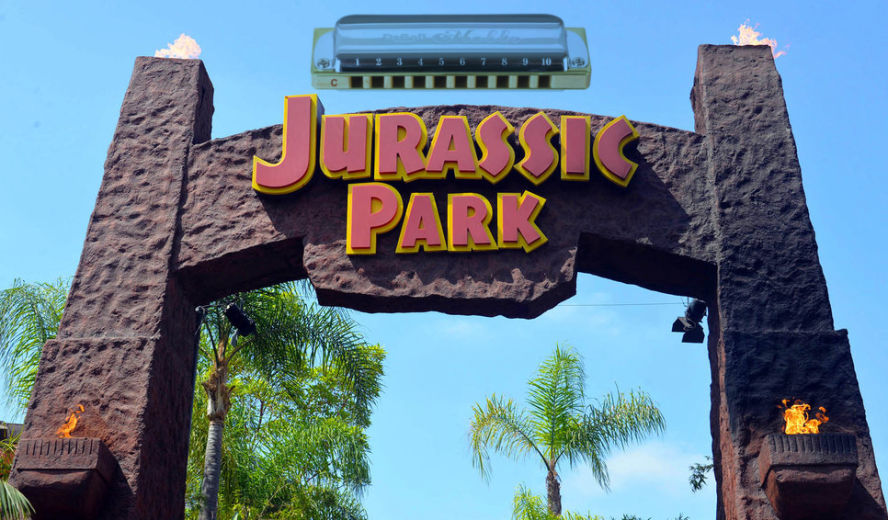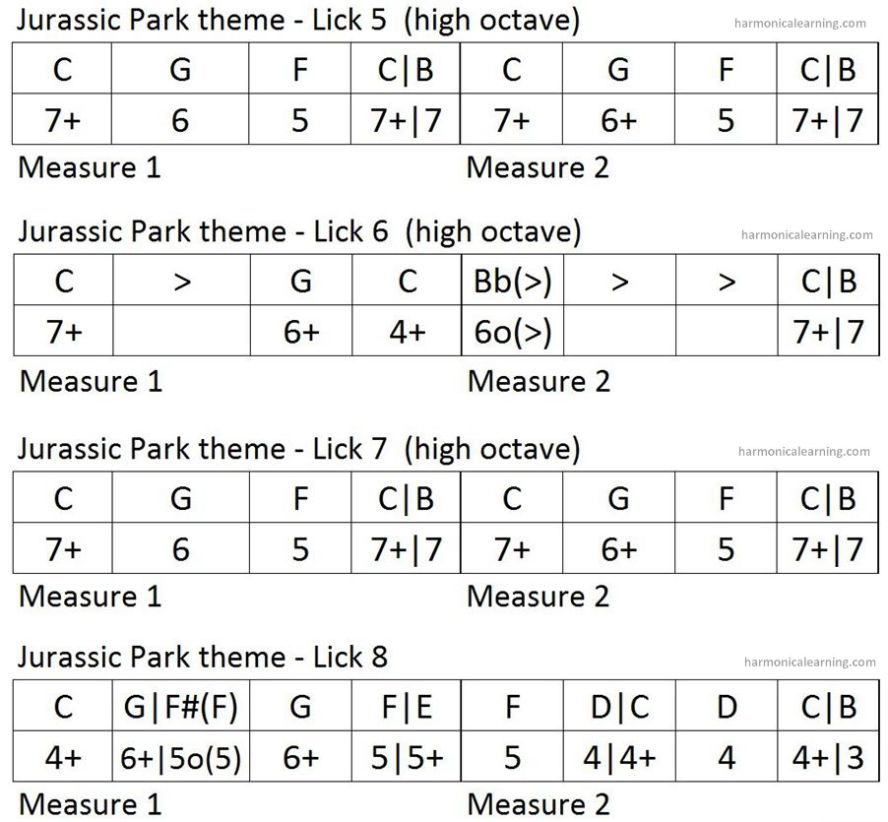
When Steven Spielberg directed the movie Jurassic Park, the main theme song was one of the aspects of the work that engaged the audience, and the melodies that compose the ‘symphony’ are really great – that’s why almost every harmonica player wants to learn to play them. I’ll immediately tell you that performing this tune isn’t really beginner-friendly, but as you will see in this lesson, with a couple of small adjustments, you can have fun and enjoy the journey even if you’re just starting out.
As I normally do with my lessons, both the play-along video and the backing track video are provided, and you can download the tabs. You’ll also find the slow version of the videos for starting your practice in a more relaxed way.
How should you study this song? I suggest you learn the single small licks first, using a metronome to help you, and once you have these down, practice alongside the play-along. The last step will be playing on the backing track.
First of all, I want to explain that this type of soundtrack is a symphony, and in performing it, there are several instruments that play together (an ensemble). The main theme can therefore be interpreted in various ways. For example, in the first part, the melody is played on a lower octave, while in the second part, other instruments are added and played on a higher octave. This way of composing and performing the songs is important, and helps to convey the emotions in the listener; when it happens, it feels like there is an 'explosion' and the music expands.
Let’s go back to how to play the Jurassic Park theme on the harmonica. The original key of the soundtrack is B flat, but since this lesson is intended for beginners, I have recreated the melodies with a harmonica in C. Of course, the chords that form the backing track also follow the same tonality.
In which position will we play Jurassic Park? As I said, we will use a harmonica in C, and we’ll be playing in first position. Benefiting from the placement of the notes on the harmonica, you have almost everything you need to perform the melodies except in a couple of points. However, don’t worry – in the tabs you can find on this page and in the videos, I wrote both the original notes and the alternative ones to make the lesson easier. In practice, instead of an overblow on hole 5, we’ll perform a hole 5 aspirated, and while we won’t play the hole 6 overblow, we’ll instead keep the previous note on hole 4 blow.
Is there an exercise that can help you play the Jurassic Park theme more easily? Of course! If you practice the major scale notes in the first position on the two harmonica octaves – on holes 1 to 4 and 4 to 7 – you will see that everything will come better and sooner than you expect!
Here are the notes: C, D, E, F, G, A, B, and C. Do you know where they are on the harmonica? I’ll give you a hint: start from the 4+ hole, and for the high octave, from 7+. Of course, on hole 10, you won’t be able to perform the blow bending to play the B note if you’re a beginner, but this doesn’t matter – you don’t actually need it to play Jurassic Park.
Here are the song chords:
C, F, C, F, G, G, F, C, G
C, F, C, F, C, Fsus, C, F, C, F, C, F, G
C, G, C
I also need to point out that after every G chord, you return to the first degree chord of the key, then C; in this case, the fifth chord resolves on the first.
Let’s analyze the melodies of the first part of the theme:
The first lick starts from hole 4 blow and is repeated in measure two. Then, the melody moves more toward the center of the harmonica and we play hole 4 draw twice, followed by a double hole 5 blow. The note on which we stop, the F, sounds very good since the underlying chord is G major.
Next, we have another lick that’s repeated twice, starting from hole 5 blow, note E, and going down to the 3 blow note G. Then, we have a jump to hole 6 to play a nice higher G. The fourth lick ends on note D, hole 4 aspirated, which sounds very good since it’s part of the underlying G chord.
All the theoretical notions you find in my lessons aren’t necessary, but they certainly won’t stop you from playing the song! You may find that studying a simple tune in this way can give you a lot more than you expect! This is my way of giving students some added value!
Below, you will find the tabs we just analyzed.

The second part of the song is played an octave up, and the whole is anticipated by the two notes that we find at the end of the lick 4 – holes 7+ and 7 draw. In this section, we repeat a new lick that starts from hole 7+, note C, and ends on hole 5, note F. Those are the two root notes of the underlying chords, C major and F major! That’s not a coincidence. In lick 6, we find the overblow that we do not play, and in its place, we hold the note C on hole 4 blow.
Then, everything is repeated until in lick 8, we replace the F sharp with a natural F on hole 5, and we find a bending on hole 4 draw that we can omit. We’ll replace it with a natural C on hole 4+. The final lick is worthy of every great symphony: TAAA, TIII, and TAAAAAAAAA. Here are the tabs of the second section of the song:

Here are the play-along videos for your practice – enjoy!
This ends our lesson for today. I hope you enjoyed it and I invite you to share it with your friends, which will help me in creating new lessons too! See you next time!
Share this page with your friends!